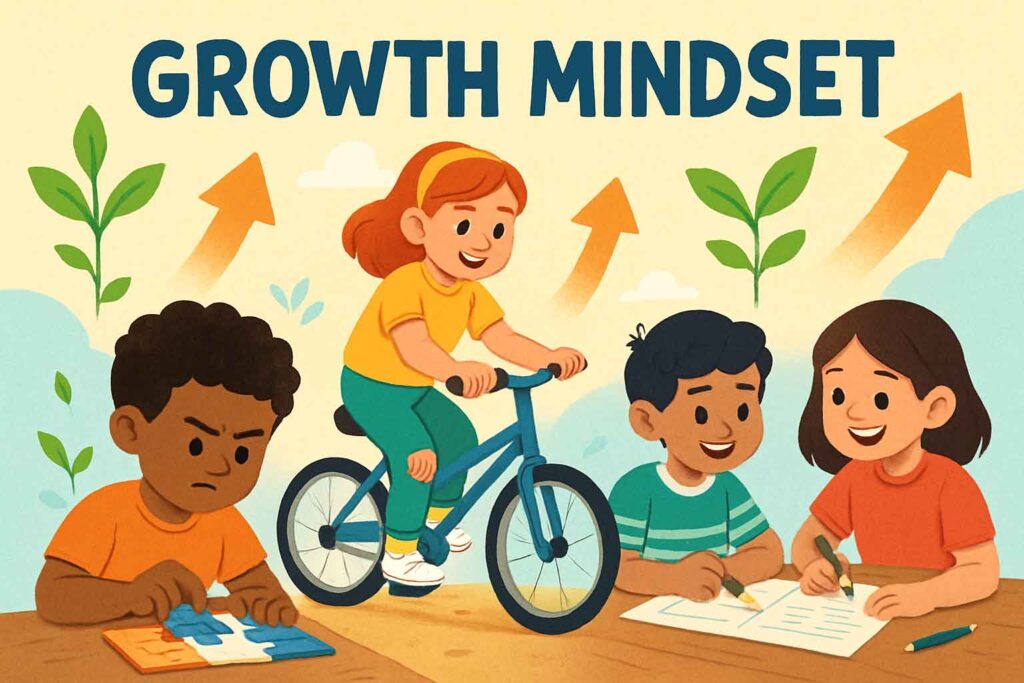Introduction
In the journey of education and personal development, one concept stands out as particularly transformative: the growth mindset. Coined by psychologist Carol Dweck, a growth mindset is the belief that abilities and intelligence can be developed through dedication and hard work. This contrasts with a fixed mindset, where individuals believe their talents are innate and unchangeable. For children, fostering a growth mindset is not just about academic success; it’s about building resilience, embracing challenges, and cultivating a lifelong love for learning. This article will explore the principles of a growth mindset, its profound benefits for children, and practical strategies for parents and educators to instill this powerful perspective.
Understanding the Growth Mindset
At its core, a growth mindset is about believing in the power of “yet.” When a child says, “I can’t do this,” a growth mindset encourages them to think, “I can’t do this yet.” This subtle shift in language reflects a fundamental difference in how individuals perceive their capabilities and setbacks.
Fixed Mindset:
•Belief that intelligence and talents are fixed traits.
•Avoids challenges to prevent failure.
•Gives up easily when faced with obstacles.
•Sees effort as fruitless.
•Ignores useful negative feedback.
•Feels threatened by the success of others.
Growth Mindset:
•Belief that intelligence and talents can be developed through effort and practice.
•Embraces challenges as opportunities to grow.
•Persists in the face of setbacks.
•Sees effort as the path to mastery.
•Learns from criticism and feedback.
•Finds inspiration in the success of others.
The Benefits of a Growth Mindset for Children
Instilling a growth mindset in children has far-reaching positive impacts on their academic performance, emotional well-being, and overall life success:
1. Enhanced Academic Achievement
Children with a growth mindset are more likely to:
•Embrace Difficult Subjects: They see challenging subjects not as barriers, but as opportunities to strengthen their understanding.
•Persist Through Struggles: When they encounter a difficult concept, they are more likely to try different strategies and seek help rather than giving up.
•Improve Learning Strategies: They actively reflect on their learning process and adapt their methods to be more effective.
2. Increased Resilience and Perseverance
Life is full of setbacks. A growth mindset equips children to handle these challenges:
•View Mistakes as Learning Opportunities: Instead of being discouraged by errors, they analyze what went wrong and how to improve.
•Bounce Back from Failure: They understand that failure is not a reflection of their inherent ability, but a temporary obstacle to overcome.
•Develop Grit: The ability to stick with long-term goals despite obstacles is a hallmark of a growth mindset.
3. Greater Enjoyment of Learning
When the focus shifts from proving intelligence to developing it, learning becomes a more joyful process:
•Intrinsic Motivation: Children are motivated by the desire to learn and improve, rather than external rewards or grades.
•Curiosity and Exploration: They are more open to exploring new topics and ideas, fostering a genuine love for knowledge.
4. Improved Social-Emotional Well-being
A growth mindset also positively influences a child’s emotional health:
•Reduced Anxiety: Less pressure to be perfect, as mistakes are seen as part of the learning process.
•Stronger Relationships: They are more open to collaboration and less threatened by the success of peers.
•Positive Self-Talk: They replace self-defeating thoughts with encouraging and constructive internal dialogue.
Practical Strategies for Cultivating a Growth Mindset
Parents and educators play a pivotal role in shaping a child’s mindset. Here are actionable strategies:
1. Praise Effort, Not Just Outcome
Instead of saying, “You’re so smart!” say, “I love how hard you worked on that!” or “Your effort really paid off!” This teaches children that effort and strategy lead to success, not just innate ability.
2. Teach About the Brain
Explain to children that their brains are like muscles that grow stronger with exercise. When they learn something new or overcome a challenge, their brain is literally making new connections. This demystifies learning and makes effort tangible.
3. Embrace Challenges and Mistakes
Encourage children to take on new challenges, even if they might fail. When mistakes happen, frame them as opportunities for learning. Ask, “What did you learn from that?” or “What will you try differently next time?”
4. Use the Power of “Yet”
When a child expresses frustration with something they can’t do, add “yet” to their statement. “I can’t ride a bike yet” implies that with practice, they will be able to.
5. Model a Growth Mindset
Children learn by observing. Share your own struggles and how you overcame them through effort and perseverance. Talk about challenges you’re facing and how you plan to tackle them.
6. Focus on Process, Not Just Product
When discussing schoolwork or projects, emphasize the strategies used, the effort invested, and the learning journey, rather than just the final grade or outcome.
7. Provide Constructive Feedback
Offer specific feedback that focuses on what the child can do to improve, rather than general criticism. For example, instead of “Your essay is messy,” say “Your essay would be clearer if you organized your paragraphs with topic sentences.”
8. Encourage Self-Reflection
Ask children to reflect on their learning: “What was challenging for you today?” “How did you overcome it?” “What are you proud of?” This helps them internalize the connection between effort and progress.
Conclusion
Cultivating a growth mindset is one of the most valuable gifts we can give to children. It empowers them to view challenges as opportunities, mistakes as stepping stones, and effort as the key to unlocking their full potential. By shifting our language and approach, parents and educators can foster a generation of resilient, lifelong learners who are not afraid to tackle the unknown and believe in their boundless capacity for growth. Let’s inspire our children to embrace the power of “yet” and embark on a journey of continuous learning and self-improvement.
